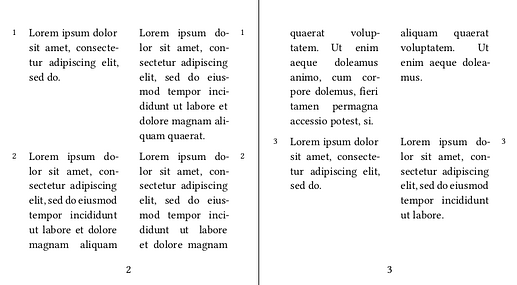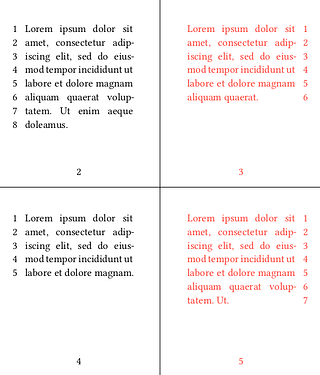But isn’t this discussing something more fancy than what the LaTeX package is doing? I mean, if the user has to tag explicitly the content for each facing pages or facing paragraphs, it’s easy to do in typst (apart from the line numbering).
Example for numbered paragraphs in parallel columns:
#set page(width: 9cm, height: 10cm, numbering: "1")
#set par(justify: true)
#let lr-blocks = state("lr-blocks", 0)
#let block-number() = context text(0.8em, numbering("1", lr-blocks.get()))
#let lr-columns(a, b) = {
lr-blocks.update(x => x + 1)
grid(columns: (1fr, 1fr), column-gutter: 2em,
place(left, dx: -1.5em, block-number()) + a,
place(right, dx: 1.5em, block-number()) + b,
)
}
#counter(page).step() // start with page 2 (left page)
#lr-columns[ #lorem(10) ][ #lorem(20) ]
#lr-columns[ #lorem(35) ][ #lorem(25) ]
#lr-columns[ #lorem(10) ][ #lorem(15) ]
Example with facing pages, and line numbering reset for each page:
#set page(width: 6cm, height: 7cm, margin: 1cm, numbering: "1")
#set par(justify: true)
#let lr-pages(a, b) = {
pagebreak(weak: true)
set par.line(numbering: "1", numbering-scope: "page", number-margin: left)
a
pagebreak()
set par.line(numbering: "1", numbering-scope: "page", number-margin: right)
set text(red)
b
}
#counter(page).step() // start with page 2 (left page)
#lr-pages[ #lorem(25) ][ #lorem(20) ]
#lr-pages[ #lorem(18) ][ #lorem(22) ]
]
What would be more difficult is to let typst do the page breaks automatically, but I don’t think the LaTeX package does that.
Also probably difficult would be to have continuous line numbering (not reset on every page).

